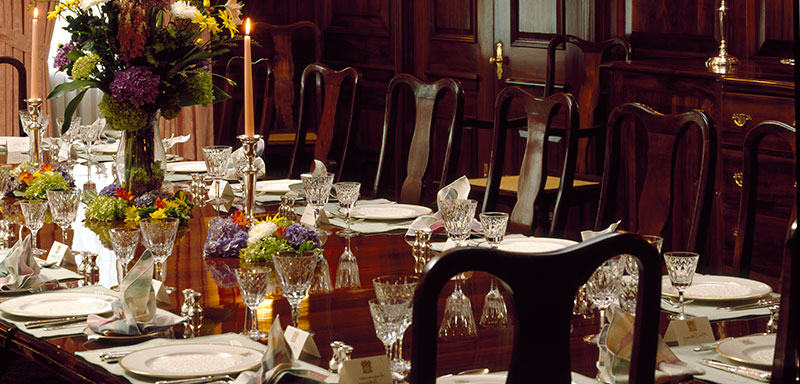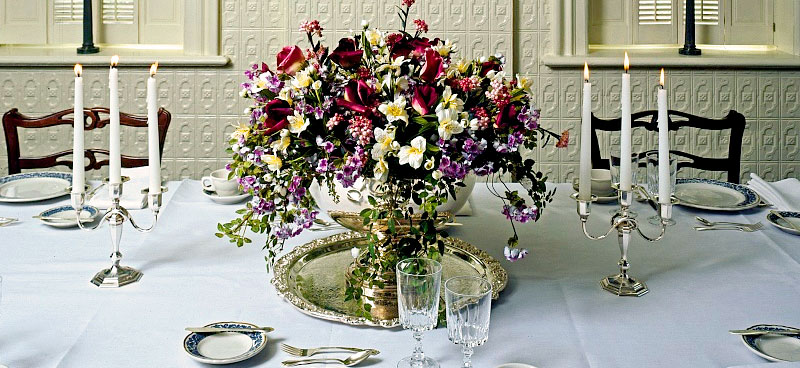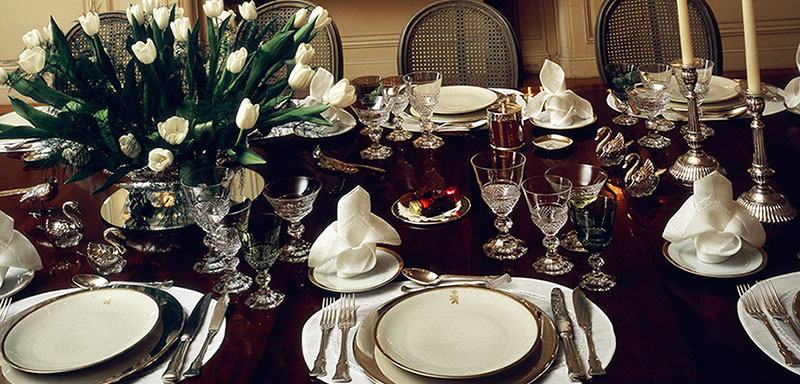Table Setting Ideas - How to Set a Formal Dinner Table

How many people know how to give a dinner, set a table properly, and serve foods and wines as they should be served, in an orderly, appetizing way? In 1891, the famous New York restaurant Delmonico's explained that one must first learn how to set a table. Epicureans might differ as to what constitutes a perfect dinner, but no one will deny that a dinner properly cooked and well served, is a delight. Moreover, if the guests are agreeable, it is perhaps one of the chief pleasures of life.
For generations, the New York restaurant Delmonico's stood for all that was good in elegant dining. Many of the famous men and women who visited New York during the nineteenth century also crossed the threshold of this world-famed restaurant. Famous dinners were given in its great white and gold dining room – politicians, statesmen, editors, artists and ministers dined and then thundered forth their after-dinner eloquence at Delmonico's. Moreover, the restaurant has sheltered beauty and wealth at hundreds of great private entertainments like the one pictured above, where rare gems gleamed and the odor of thousands of roses made one almost believe that fairyland was a reality. During the late 1800s, Delmonico's had no rival in America, if indeed in the world. Everything was on the most lavish scale – rich, rare and costly.

A detail of a vintage Delmonico’s menu from October 23, 1917. This menu featured over 200 items to feast upon, including: Lobster Cocktail, Beluga Caviar, Blue Point Oysters, Smoked Salmon in Oil, Gumbo, Creole, Green Turtle Soup, Mignon Of Lamb Benoit, Boneless Squab Stuffed Foie Gras, Roast Saddle Of Spring Lamb, Roast Pheasant, Oyster Bay Asparagus, Brussels Sprouts With Chestnuts, Potatoes Hashed In Cream, Watercress Salad with French Dressing, plus assorted Ice Creams, Puddings, and Desserts. The New York Public Library has this complete menu in its irresistible collection of 17,000 period restaurant menus with the oldest dating back to the 1850s.
Throughout the late 19th century, city dinner-giving in New York City was carried on to an extent only equaled in London and Paris. Much use was made of flowers, candelabra, colored lights, silverware, silver and gold plate. But all people cannot serve the exotic foods found on the Delmonico's menu on gold or silver plates; and not all of us possess handsomely decorated period dining rooms. For the lack of these, you can still create the ambiance of the well-to-do Victorian and Edwardian New Yorkers in less expensive ways. And one of the most important factors is a well set and attractive table with snowy linen, polished glass and china, and brightly burnished silverware. In 1891, Delmonico's gave this advice on how to set a formal dinner table to the readers of The Ladies Home Journal.

A dining room featuring a center large table with a round table setting including flowers, table linens, china and crystal, and every appointment necessary for an intimate formal dinner party. A round table lends itself more easily to decoration than a square one and makes it easier to engage in general conversation.
#1 Round Table Setting
According to Delmonico's, one must first learn how to set a table. A round table is better than a square table, if the dining room is large enough to permit it. It is easier to seat people at a round table setting, as well as it provides a more intimate atmosphere for conversation. If a round table is not available, then the ordinary oblong extension table can be used. Nevertheless, if more than six or eight guests are to be seated, the greater diameter of a sufficiently large round table is likely to remove opposite guests to too great a distance to be sociable.

Floral centerpieces in a formal table setting should be simple and not high enough to obstruct the view across the table. The lights should be shaded and placed no higher than the heads of the guests. Candles may stand just outside the centerpiece or may be placed near the four corners of a square table. [PHOTO: DINING ROOM TABLE AT THE SAINT JAMES HOTEL, WHICH OPENED IN 1875 IN RED WING, MINNESOTA. PHOTOGRAPHS IN THE CAROL M. HIGHSMITH ARCHIVE, LIBRARY OF CONGRESS, PRINTS AND PHOTOGRAPHS DIVISION]
#2 Flowers
Flowers should never be absent from the dinner table. No matter how homely, they add to the picturesqueness of the feast. The table decorations of flowers must always be in keeping with the color of the dinner decided on, and consist of a large center vase of flowers, not high enough to obstruct the view across the table. It should extend within ten inches of the inner edge of the plates. A few hostesses like to have large bouquets at each end of the table also, but this is not necessary. A pretty idea is to decorate the chandelier above with smilax and flowers.
The corsage bouquets for the ladies are placed at their right hand, just in front of the plate; while the gentleman's boutonnière is placed on his napkin, with his dinner card.
Furthermore, it is important that the temperature of the room is kept a little cool, rather than a degree too warm. An over-heated dining room is an abomination for guests.

The table should be supplied with a handsome and spotless damask cloth over a heavy silence cloth. The tablecloth should extend at least a quarter of a yard over the edge of the table. At times an elaborate lace tablecloth covers the damask table linens. [PHOTO: DETAIL OF THE DINING ROOM OF THE MCFADDIN-WARD HOUSE IN BEAUMONT, TEXAS. PHOTOGRAPHS IN THE CAROL M. HIGHSMITH ARCHIVE, LIBRARY OF CONGRESS, PRINTS AND PHOTOGRAPHS DIVISION]
#3 Table Linens
For a formal dinner party, on the table is first placed a thick flannel cloth, the thicker it is the better as it prevents noise from the dishes as they are placed on it. Over this is spread a snowy white damask tablecloth; it should be monogrammed if possible. Sometimes over this is placed still another, of elaborate embroidery and lace, lined with pink or yellow satin, as taste dictates, or whatever color is to predominate at the dinner. The plates are first placed upon the table. As these are to remain until after soup is served, they are always the handsomest in the gold or china sets, as the case may be.

#4. Table Setting
Don't crowd. Each guest should be allowed a space of two feet or twenty-six inches, if the table will permit it, and the plates placed at equal distances apart. Place two dinner forks to the left of each plate and also an oyster fork with prongs resting on the edge of the plate. On the right must be a dinner knife and a spoon for soup.

The glasses are arranged at the right of each guest on a line with the inner edge of the plate. The water glass is set next to the plate; then glasses for whatever other beverages are intended to be served. If wines are objectionable, any of the best mineral waters can be used throughout the dinner, with French coffee at the close. A glass, whether of water or any other liquid, should never be filled more than three-quarters full.

#5 Table Centerpiece
In the middle of the table is the big centerpiece of silver and at each end a handsome candelabra of silver or crystal. In between are silver composers of fruit, one at each end, and four low compotiers — two at each end — filled with cakes and marron glacés. Two other dishes of fruits glacé are placed one at either end. These dishes of glacés are used principally at winter dinners. In the summer, different kinds of fresh fruit are substituted in their stead.
Two compotiers, which stand on either side of the centerpiece, are filled with favors for the ladies, and may be anything that the fancy dictates. Six silver shells, three on each side, are filled with olives and salted almonds, to be served after the soup. Six or eight handsome salt-cellars are usually placed on the table, each one serving two guests.

#6 Napkins or Serviettes
The napkins or serviettes to be used are large damask, over-folded so as to reveal the monogram, and each forms the receptacle for a dinner bread roll. When the roll is taken out of the napkin by each guest, it should always be placed at the left of the plate. The name cards must be placed on the top of the napkin, and the menu cards at the right of the plate.

#7 Side Table
On a side table is all the extra silver and china required. The plates are of course changed, after soup, with each course, until cream and fruits, which are the last things on the menu.
If decanters, handsome glass jugs covered with silver, are used, they are placed at opposite corners of the table — one at each corner, making four in all. These generally contain claret and sherry.
The finger bowls, which may be of gold, silver, or enamelware, or very fine glass, are not placed on the table until after the ices and fruits have been served. They are then put on handsome dessert plates with fine embroidered doilies.
[Edited from The Ladies Home Journal, 1891. Author: Foster Coates. Photographs: the Carol M. Highsmith Archive, Library of Congress, Prints and Photographs Division]




